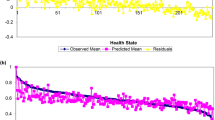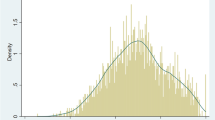Abstract
Background
Different countries have different preferences regarding health, and there are different value sets for popular preference-based measures across different countries. However, the cost of collecting data to generate country-specific value sets can be prohibitive for countries with smaller population size or low- and middle-income countries (LMIC). This paper explores whether existing preference weights could be modelled alongside a small own country valuation study to generate representative estimates. This is explored using a case study modelling UK data alongside smaller US samples to generate US estimates.
Methods
We analyse EQ-5D valuation data derived from representative samples of the US and UK populations using time trade-off to value 42 health states. A nonparametric Bayesian model was applied to estimate a US value set using the full UK dataset and subsets of the US dataset for 10, 15, 20 and 25 health states. Estimates are compared to a US value set estimated using US values alone using mean predictions and root mean square error.
Results
The results suggest that using US data elicited for 20 health states alongside the existing UK data produces similar predicted mean valuations and RMSE as the US value set, while 25 health states produce the exact features.
Conclusions
The promising results suggest that existing preference data could be combined with a small valuation study in a new country to generate preference weights, making own country value sets more achievable for LMIC. Further research is encouraged.



Similar content being viewed by others
References
Drummond, M.F., Sculpher, M., O’Brien, B., Stoddart, G.L., Torrance, G.W.: Methods for the economic evaluation of health care programmes. Oxford Medical Publications: Oxford (2005)
Brooks, R.: EuroQol: the current state of play. Health Pol. 37, 53(72 (1996). https://doi.org/10.1016/0168-8510(96)00822-6
Torrance, G.W., Feeny, D.H., Furlong, W.J., et al.: Multi-attribute utility function for a comprehensive health status classification system: health utilities index mark 2. Med. Care. 34(7), 702–722 (1996). https://doi.org/10.1097/00005650-199607000-00004
Feeny, D.H., Furlong, W.J., Torrance, G.W., et al.: Multi-attribute and single-attribute utility function for the health utility index mark 3 system. Medical care 40(20), 113(128 (2002)
Hawthorne, G., Richardson, G., Atherton_Day, N.: A comparison of the assessment of quality of life (AQoL) with four other generic utility instruments. Ann. Med. 33, 358–370 (2001). https://doi.org/10.3109/07853890109002090
Kaplan, R.M., Anderson, JP: A general health policy model: update and application. Health Serv. Res. 23, 203–235 (1988)
Brazier, J.E., Roberts, J., Deverill, M.: The estimation of a preference based measure of health from the SF-36. J. Health Econ. 21, 271(292 (2002). https://doi.org/10.1016/S0167-6296(01)00130-8
Rowen, D.L., Brazier, J., Ara, R., Azzabi Zouraq, I.: The role of condition-specific preference-based measures in health technology assessment. PharmacoEconomics 35(Suppl 1), 33–41 (2017)
Badia, X., Roset, M., Herdman, M., et al.: A comparison of United Kingdom and Spanish general population time trade-off values for EQ-5D health states. Med. Decis. Making. 20, 7–16 (2001). https://doi.org/10.1177/0272989X0102100102
Johnson, J.A., Luo, N., Shaw, J.W., et al.: Valuations of EQ-5D Health States: are the United States and United Kingdom different. Med. Care. 43, 221–228 (2005). https://doi.org/10.1097/00005650-200503000-00004
Rowen, D.L., Azzabi Zouraq, I., Chevrou-Severac, H., van Hout, B.: International regulations and recommendations for utility data for health technology assessment. PharmacoEconomics 35(Suppl 1), 11–19 (2017)
Kharroubi, S.A., O’Hagan, A., Brazier, J.E.: A comparison of United States and United Kingdom EQ-5D health state valuations using a non-parametric Bayesian method. Stat. Med. 29, 1622–1634 (2010). https://doi.org/10.1002/sim.3874
Kharroubi, S.A., Brazier, J., McGhee, S.: A comparison of Hong Kong and United Kingdom SF-6D health states valuations using a non-parametric Bayesian method. Value Health. 17(4), 397–405 (2014). https://doi.org/10.1016/j.jval.2014.02.011 (PMid: 24969000).
Kharroubi, S.A.: A comparison of Japan and United Kingdom SF-6D health states valuations using a non-parametric Bayesian method. Appl. Health Econ. Pol. 13, 409–420 (2015). https://doi.org/10.1007/s40258-015-0171-8. (PMid: 25896874)
The EuroQol Group (1990) EuroQol—a new facility for the measurement of health-related quality of life. Health Policy 16(3), 199–208
Brazier, J.E., Ratcliffe, J., Tsuchiya, A., Solomon, J.: Measuring and valuing health for economic evaluation. Oxford University Press, Oxford (2007)
Dolan, P.: Modeling valuation for Euroqol health states. Med. Care 35, 351–363 (1997)
Shaw, J.W., Johnson, J.A., Coons, S.J.: US valuation of the EQ-5D health states: development and testing of the D1 valuation model. Med. Care 43(3), 203–220 (2005)
Patrick, D.L., Starks, H.E., Cain, K.C., Uhlmann, R.F., Pearlman, R.A.: Measuring preferences for health states worse than death. Med. Decis. Making 14, 9–18 (1994)
Kharroubi, S.A., O’Hagan, A., Brazier, J.E.: Estimating utilities from individual health state preference data: a nonparametric Bayesian approach. Appl. Stat. 54, 879–895 (2005). https://doi.org/10.1111/j.1467-9876.2005.00511.x
Acknowledgements
The leading author would like to thank the University Research Bureau (URB) at the American University of Beirut, Lebanon, for funding this study. The authors would particularly like to thank Prof. John E Brazier for all his continual support and useful guidance during their time working on this manuscript. This work was supported by American University of Beirut (103366).
Funding
This study was funded by the University Research Bureau (URB) at the American University of Beirut, Lebanon.
Author information
Authors and Affiliations
Corresponding author
Ethics declarations
Conflict of interest
The authors declare that they have no conflict of interest.
Ethical approval
This article does not contain any studies with human participants or animals performed by the authors.
Rights and permissions
About this article
Cite this article
Kharroubi, S.A., Rowen, D. Valuation of preference-based measures: can existing preference data be used to select a smaller sample of health states?. Eur J Health Econ 20, 245–255 (2019). https://doi.org/10.1007/s10198-018-0991-1
Received:
Accepted:
Published:
Issue Date:
DOI: https://doi.org/10.1007/s10198-018-0991-1




